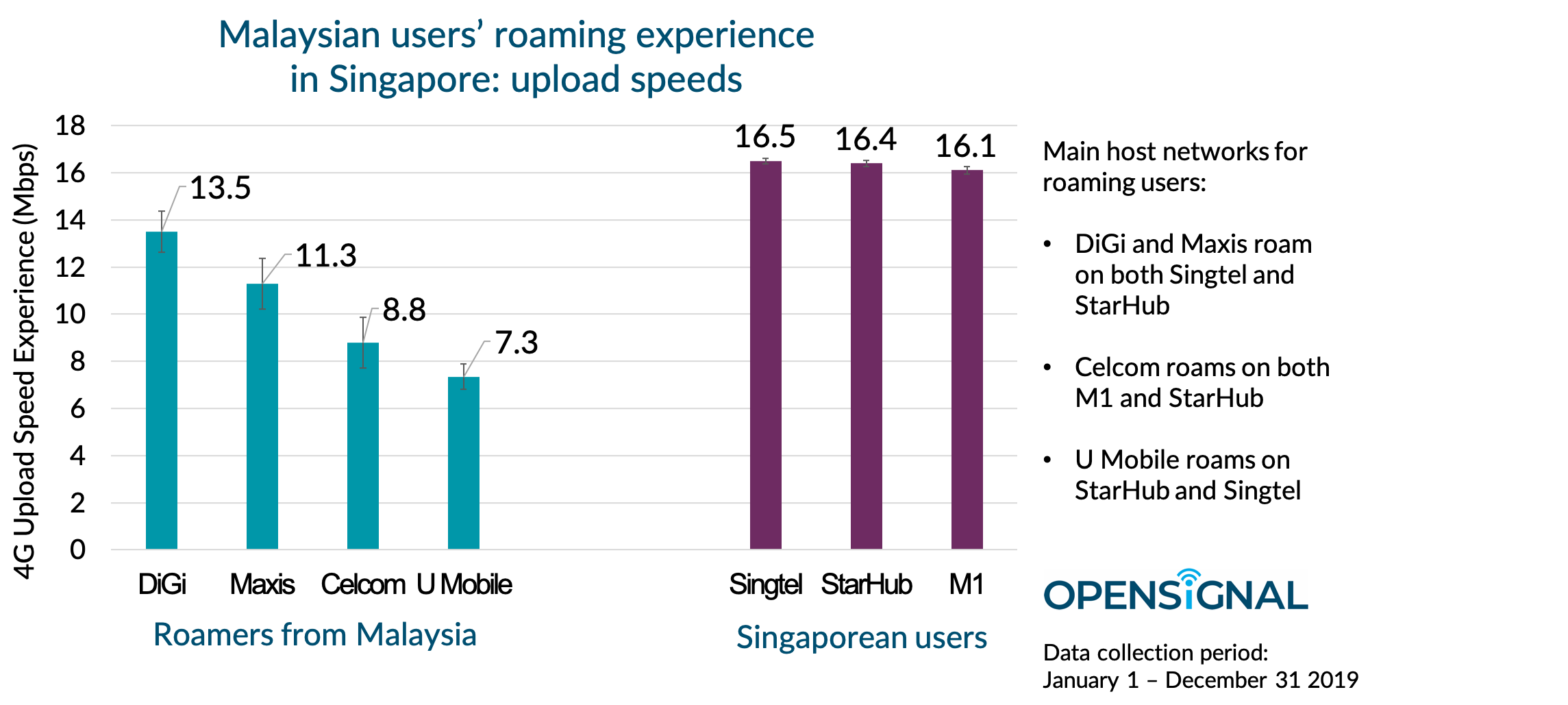In this analysis we look at how three measures of the mobile user experience vary between international roamers from Malaysia and domestic users in Singapore. We analyzed the roaming experience of those 4G users that travelled from Malaysia to Singapore during 2019 and are customers of Malaysia’s four largest operators by market share (as stated by the MCMC in its latest Industry Performance report).
Opensignal found that DiGi users enjoyed the best mobile Download Speed Experience, Upload Speed and Latency Experience while roaming in Singapore when compared with Malaysian roamers that are customers of other Malaysian operators. We also found considerable differences between the mobile experience seen by Malaysian roamers in Singapore and that observed by domestic Singaporean users.
Operators typically have roaming agreements with one or more host networks, allowing their customers to roam on them while abroad. We detected that when in Singapore, DiGi and Maxis users typically roam on Singtel and StarHub, Celcom users most often roam on both M1 and StarHub, while U Mobile users typically roam on StarHub with Singtel also being used.

As you can see from the chart above, the Download Speed Experience observed by Malaysian roamers is slower than the speeds enjoyed by Singaporean domestic users. This is particularly pronounced for U Mobile users (who typically roam on StarHub and Singtel), who observed an average Download Speed Experience of 16.6 Mbps — 40.4 Mbps less than the 56.9 Mbps seen by StarHub’s domestic users and 38.1 Mbps less than the speeds observed by Singtel domestic users.
The smallest difference between the Download Speed Experience seen by roamers from Malaysia and domestic Singaporean users was that between DiGi roamers and their Singtel and StarHub counterparts (7.8 Mbps and 10.1 Mbps), respectively. Also, DiGi users observed the highest Download Speed Experience when roaming in Singapore.
We observed a similar pattern for Upload Speed Experience, albeit with a more pronounced difference between the speeds reported by roaming Maxis and Celcom customers and with less variation between those seen by domestic customers of different operators.

Finally, we turn once more to Latency Experience. This time — and in contrast to what we observed in Malaysia, in Singapore all Malaysian roamers observed much higher latencies than domestic users, regardless of their choice of home operator. Celcom users observed the highest (and hence the slowest) Latency Experience of 48.8ms — slightly more than twice that seen by M1 users and nearly twice that observed by StarHub users.

We’ve seen that out of the four main Malaysian operators, when roaming in Singapore DiGi users enjoyed the fastest Download Speed Experience, Upload Speed Experience and Latency Experience. We’ve also shown that the roaming experience in terms of both download and upload speeds can be significantly worse than that observed by domestic customers on the same host network.
If you’d like to know how the mobile experience of Singaporean roamers in Malaysia varies by operator and how it compares with that of domestic Malaysian users, please see our Insight on this topic here.
Finally, If you’re curious as to how international roaming works, here’s a simplified diagram:

Because of the way in which international roaming works, differences in the average mobile experience observed between roamers and domestic users may arise due to differences in the mix of mobile devices they’re using and the locations where they spend most of their time (as the mobile experience is typically superior in urban areas). There’s also the potential impact from the additional latency and potential bottlenecks created by having to relay the information between host and home core networks and between the home core and the content delivery networks. For more on how international roaming works, see the GSMA’s guide to this topic.
Opensignal Limited retains ownership of this insight including all intellectual property rights, data, content, graphs & analysis. Reports and insights produced by Opensignal Limited may not be quoted, reproduced, distributed, published for any commercial purpose (including use in advertisements or other promotional content) without prior written consent. Journalists are encouraged to quote information included in Opensignal reports and insights provided they include clear source attribution. For more information, contact [email protected].
